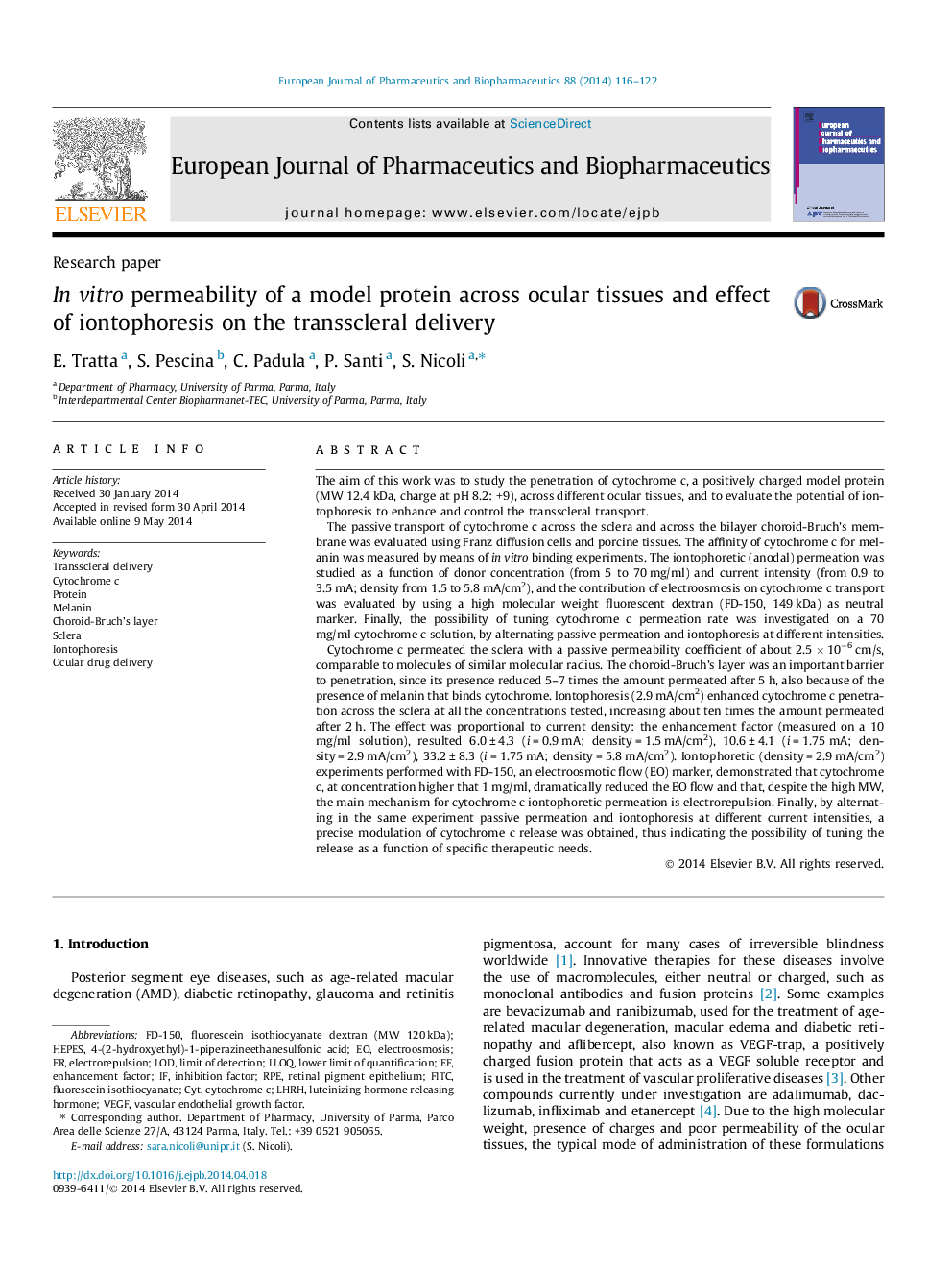| کد مقاله | کد نشریه | سال انتشار | مقاله انگلیسی | نسخه تمام متن |
|---|---|---|---|---|
| 2083590 | 1545339 | 2014 | 7 صفحه PDF | دانلود رایگان |

• The penetration of cytochrome c across different ocular tissues was studied.
• Anodal iontophoresis was evaluated as enhancing strategy.
• Sclera, choroid-Bruch’s membrane and melanin represent important static barriers.
• Iontophoresis enhanced the permeation proportionally to current density.
• Current modulation can be used to finely tune cytochrome c transport.
The aim of this work was to study the penetration of cytochrome c, a positively charged model protein (MW 12.4 kDa, charge at pH 8.2: +9), across different ocular tissues, and to evaluate the potential of iontophoresis to enhance and control the transscleral transport.The passive transport of cytochrome c across the sclera and across the bilayer choroid-Bruch’s membrane was evaluated using Franz diffusion cells and porcine tissues. The affinity of cytochrome c for melanin was measured by means of in vitro binding experiments. The iontophoretic (anodal) permeation was studied as a function of donor concentration (from 5 to 70 mg/ml) and current intensity (from 0.9 to 3.5 mA; density from 1.5 to 5.8 mA/cm2), and the contribution of electroosmosis on cytochrome c transport was evaluated by using a high molecular weight fluorescent dextran (FD-150, 149 kDa) as neutral marker. Finally, the possibility of tuning cytochrome c permeation rate was investigated on a 70 mg/ml cytochrome c solution, by alternating passive permeation and iontophoresis at different intensities.Cytochrome c permeated the sclera with a passive permeability coefficient of about 2.5 × 10−6 cm/s, comparable to molecules of similar molecular radius. The choroid-Bruch’s layer was an important barrier to penetration, since its presence reduced 5–7 times the amount permeated after 5 h, also because of the presence of melanin that binds cytochrome. Iontophoresis (2.9 mA/cm2) enhanced cytochrome c penetration across the sclera at all the concentrations tested, increasing about ten times the amount permeated after 2 h. The effect was proportional to current density: the enhancement factor (measured on a 10 mg/ml solution), resulted 6.0 ± 4.3 (i = 0.9 mA; density = 1.5 mA/cm2), 10.6 ± 4.1 (i = 1.75 mA; density = 2.9 mA/cm2), 33.2 ± 8.3 (i = 1.75 mA; density = 5.8 mA/cm2). Iontophoretic (density = 2.9 mA/cm2) experiments performed with FD-150, an electroosmotic flow (EO) marker, demonstrated that cytochrome c, at concentration higher that 1 mg/ml, dramatically reduced the EO flow and that, despite the high MW, the main mechanism for cytochrome c iontophoretic permeation is electrorepulsion. Finally, by alternating in the same experiment passive permeation and iontophoresis at different current intensities, a precise modulation of cytochrome c release was obtained, thus indicating the possibility of tuning the release as a function of specific therapeutic needs.
Figure optionsDownload high-quality image (63 K)Download as PowerPoint slide
Journal: European Journal of Pharmaceutics and Biopharmaceutics - Volume 88, Issue 1, September 2014, Pages 116–122